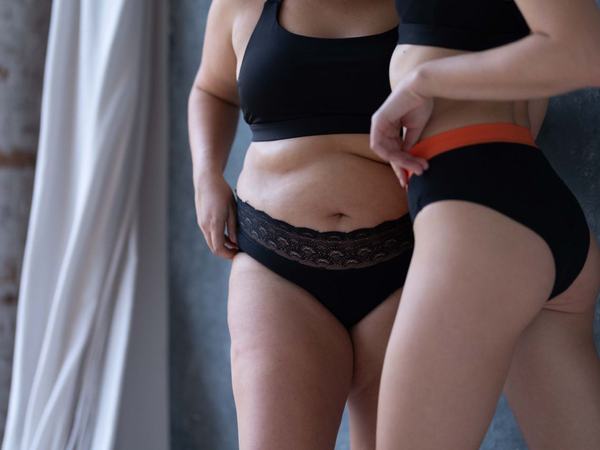The postpartum and period underwear
The female body is special and phenomenal because it can carry life and give birth. One of the best things about pregnancy (aside from the baby being born) is the almost year-long break from menstruation, which means you don't need pads, tampons or period underwear. No random monthly bleeding. Isn't that amazing? Of course it is, but once the baby arrives, your body finds a way to compensate you for that break.

Unfortunately, this means that after you give birth, everything is not the same as it was before. This transition usually lasts several months and is often accompanied by some symptoms that aren't necessarily pleasant. These symptoms include postpartum bleeding and sometimes urinary incontinence. Your body needs time to recover, which means that for days or weeks after delivery, you may still have some problems related to pregnancy and even more related to childbirth. However, a better understanding of what's going on in your body can help make this transition period easier to manage.
What happens during postpartum bleeding?
Postpartum hemorrhage, also called lochia, is a form of bleeding and vaginal discharge that occurs after delivery. Regardless of whether you had a vaginal delivery or a cesarean section, you will have postpartum hemorrhage. This is your body's way of getting rid of the extra blood and tissue in your uterus that helped your baby grow. Your uterus sort of starts over and sheds the blood, tissue, and other materials left over from the months of pregnancy. Lochia smells like menstrual blood and can last for about six weeks. Some describe the smell as musty, metallic, sour or stale. However, it should not smell fishy or foul. This could mean that bacteria have entered your vagina and caused an infection.
What should be expected?
Everyone is different, but in general, lochia runs a similar course in terms of color and quantity. The blood is bright red, can be heavy on the first day, and some clots may be seen in the first few days after delivery. Between the fourth and seventh day, the blood should turn a pinkish or brownish color. The clots should get smaller or disappear.
It's also normal to sometimes feel a gush of blood when you stand up. This is because of the shape of the vagina. When you sit or lie down, blood collects in a bowl-shaped area. When you stand, it leaks out. When this happens, your feet should stay still and rest a little.
When do I need to see a health care provider about postpartum hemorrhage?
You can see your health care provider if you notice any of the following symptoms, which may indicate an infection or a condition more serious than natural postpartum bleeding:
- Very large blood clots (about the size of a lemon or larger)
- Foul-smelling lochia (normal lochia should smell like a normal period)
- Bright red bleeding beyond the third day after delivery
- Bleeding that soaks through more than one sanitary pad per hour and does not subside or stop
- Fainting, shortness of breath, dizziness or rapid heartbeat
- Nausea or vomiting
- Swelling or pain in the vaginal area
- Fever or chills
What is postpartum incontinence?
During and after pregnancy, women may experience involuntary leakage of urine, which is called urinary incontinence. Childbirth is extremely stressful on the body and can alter a woman's ability to control urine output. During pregnancy, the weight of the expanding uterus can weaken the strength of a woman's pelvic floor muscles and cause urine leakage.
Although incontinence is common after childbirth, many new mothers are embarrassed by this physical change, but it is nothing to be ashamed of. There are different types of urinary incontinence, but most postpartum women suffer from stress incontinence. Laughing, coughing, sneezing, jumping and other activities can put extra pressure on the bladder sphincter, the muscle valve at the bottom of the bladder that controls the flow of urine. This pressure can cause urine to leak during these activities (stress incontinence). Women should talk to a doctor or pelvic floor health specialist six weeks after delivery if incontinence persists, as this may indicate another condition.
How can postpartum bleeding be managed?
There is a whole market of specially designed postpartum underwear for this question. You shouldn't use internal hygiene products like tampons and menstrual cups, as these can introduce bacteria into the still-recovering uterus and genital tract. Pads may not be such a good idea because you have to opt for the extremely thick size, which can be uncomfortable and need to be changed every few hours.
In general, there are three categories of underwear for postpartum:
- Disposable briefs
- Period underwear, which is thicker and can absorb heavy menstrual and postpartum blood
- Lightweight compression underwear

There are not only different types, but also different designs of postpartum underwear. These include:
- High-waisted briefs (a good option if you've had a C-section).
- Crossover underpants (which also work well as maternity underwear)
- Boy shorts
- Bikinis (although these tend to be less popular).
Conclusion
The birth of a child is an important transitional period in a woman's life. It may take some time for you to get used to the changes that take place in your body and mind after giving birth.
You should make sure to take it easy during the postpartum recovery period, because doing too much too soon can slow down the body's repair work and cause bleeding to start again or become heavier.
While it's impossible to pinpoint exactly when, your first period after birth may depend on how often you breastfeed. The reason? It's a hormonal thing. If you're not breastfeeding, your period may return as early as four weeks after birth, although that's not typical. Six to 12 weeks is average for most women. If you're exclusively breastfeeding, you'll probably have a longer break from your monthly cycle than other new moms. In short, there is no typical pattern to your first period after having a baby.
Image sources
All images were provided by Weekiss for this article.
No comments yet.